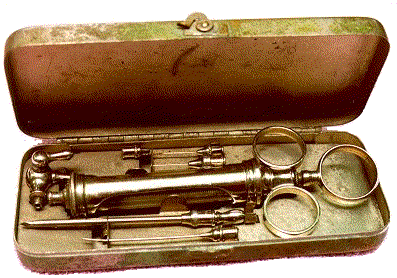
Long before today's disposable plastics, hypodermic syringes were made of metal and later glass. The whole process of administering medication by hypodermic was not sterile, the separate components of the syringe were cleaned by several techniques including passing the needle through a flame, soaking or drawing through with alcohol or a carbolic acid solution or boiling in a spoon of water over the alcohol lamp. A wire was used to clean the inside of the needle, as was alcohol. Before stainless steel was used, the wire was left in the needle. The needles were sharpened by the user on a whetstone and the point was tested for burrs using gauze. These were not fine or sharp needles and it took a skillful nurse to administer an injection with minimal pain.

As for other advances in technology, hypodermic injections were first the domain of the physicians and nurses only had to clean the syringes. Nurses use of syringes before 1930 was largely restricted to subcutaneous injection (Sandelowski, 1997).

Early in the twentieth century nurses, who were primarily private duty nurses, owned their own syringe sets. It was not unusual for graduating nurses to be given a syringe set as a graduating gift. These may have been marked with a pharmaceutical company name, and in some schools, was a gift from the physicians.
Old syringes, especially in a complete kit as shown above, are collectible. The rubber gaskets in the plunger will deteriorate and the metal may tarnish or corrode. Even more recent kits with glass syringes in a plastic case, are collectible.
Hampton, I.A. (1893). Nursing: Its principles and practice. Philadelphia: W. B. Saunders.
Sandelowski, M. (1997). "Making the best of things": Technology in American
nursing, 1870-1940. Nursing History Review, 5, 3-22
